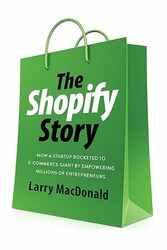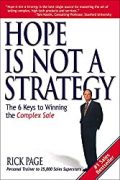
Rating: 7.3/10.
The Shopify Story: How a Startup Rocketed to E-commerce Giant by Empowering Millions of Entrepreneurs by Larry MacDonald
Book that tells the history of Shopify, from a humble online snowboard store to one of the largest e-commerce companies and the largest tech company based in Canada. It is meticulously researched, offering extensive details from product launches to quotes from key executives, decision-makers, and the CEO. Unlike many business books of this type, the book is packed with facts and does not attempt to tell a compelling narrative. The density of details can make it challenging for a casual reader to enjoy, although it provides an in-depth look at the Shopify business, including the numerous products and initiatives the company has launched over the years, detailing how it has targeted different stakeholders and segments while responding to crises and opportunities. It is also overwhelmingly positive about the company, and not the source of a balanced view that weighs the positives and negatives.
The story of Shopify begins with its founder, Tobias Lütke, who grew up in Germany and started his career working for various tech companies. Often described as brilliant and passionate about gaming, particularly Starcraft, Lütke eventually grew bored of his tech job. In 2004, encouraged by his partner Fiona McKean to pursue entrepreneurship, he started selling snowboards online. Disappointed with the limited options available for building e-commerce sites at that time, he began coding his own platform using Ruby on Rails. They launched Shopify in 2005 to make it easier for similar websites to get started, and by 2007, it had become a rapidly growing business with an increasing number of customers every quarter. They set up an office in Ottawa in 2007.
Shopify nearly went bankrupt but recovered after changing their pricing model to a flat fee rather than a proportion of sales. Initially, Lütke served as the CTO and searched for a suitable CEO but did not find one he liked, so he assumed the CEO role himself. During the financial crisis, there was an unexpected influx of new customers in 2008 as people lost their jobs and tried to start online businesses.
As their marketing efforts grow serious, Shopify launches an App Store and contests for marketing, and they diversify the executive team with people from various backgrounds, including marketing, legal, and finance. The company grows quickly, acquiring new customers and raising a Series A in 2010, which is quickly followed by Series B and C in the next few years. They hire executive coaches to help manage the growing team and invest in a portfolio of e-commerce-related companies, three of which are now public, and their earnings affect Shopify’s share price due to the large amount of ownership.
Finkelstein is put in charge of business development, and his team hires “gurus” with experience in starting online stores and understanding the product well to handle support; they improve tools, enabling users to print shipping labels more quickly and track supplier shipments. The Shopify office is set up in a vibrant part of downtown Ottawa, and encourages small teams of skilled people who move quickly and support each other, especially since they have acquired many startups with capable founders. Shopify enables smaller players to enter e-commerce without needing traditional retailers, such as: direct-to-consumer strategies; leveraging celebrities with large followings to quickly launch physical products; dropshippers (although the latter has gained a poor reputation for lack of quality).
Then Shopify expanded its offerings to a retail operating system, aiming to encompass all of the software needs of a retail operation, such as point-of-sale devices and tools for managing social media, etc. Notably, Shopify Payments became a successful product, offering an alternative to payment processors that charge a percentage of sales instead of a subscription fee, which generated significant revenue for the company. Shopify went public in 2015, and in the following years, despite attempts to undermine its stock by claiming its business was unreliable, its revenues consistently exceeded expectations, leading to steady growth in its stock price post-IPO and making some early employees quite wealthy. After the IPO, much of the company’s efforts focused on improving the retail operating system to attract and retain larger and enterprise customers, moving beyond its reputation for serving small online stores, such as: partnerships with social media sites like Facebook and TikTok, and banking features such as lines of credit and loans to merchants, using data science to assess the risk of financial loans.
As the business continued to grow, some of the engineering challenges faced included supporting mobile platforms, refactoring the codebase into microservices, and protecting against bots, hackers, and financial fraud. Shopify then expanded internationally and beyond its core offerings, such as accepting cryptocurrency payments and selling NFTs. It also took advantage of cannabis legalization in Canada, enabling most of these stores to run on Shopify. Around that time, they launched a fulfillment network similar to Amazon Prime. Shopify is now the second-largest e-commerce company in the US after Amazon, but they occupy different segments, so they mostly don’t compete with each other. Amazon excels at offering standard items at the lowest prices, whereas Shopify is more geared towards entrepreneurs selling unique items that don’t have a standard barcode.
COVID marked the next significant change in Shopify’s history, and the company prioritized features that helped small businesses survive. It launched a mobile app but decided not to include a search function across all sites, as this would make it too similar to Amazon. Shopify stores have also become attractive for buying and selling on marketplace platforms. Some cultural issues included a lack of work-life balance, and some criticized Shopify’s high-growth and high-expectations culture, which is more chaotic than that of larger companies. However, its supporters defended that this approach is necessary for a high-growth model.
The business grew quickly during COVID, but once in-person shopping resumed in 2022, online sales dropped back to previous levels, and the company experienced negative feedback for lack of work-life balance. Additionally, there was a crisis with Amazon marketing the Prime fulfillment network to Shopify merchants, but this was eventually resolved. From 2022 onwards, Shopify reduced its headcount and aimed for a leaner operation, such as increasing prices for subscriptions and reducing inefficiencies in its internal processes. Some new launches include integration with ChatGPT, collaborations with large YouTubers, and venturing into live stream shopping, where China has the lead in this space. In conclusion, Shopify has come full circle from being entrepreneurs themselves selling snowboards to becoming a comprehensive platform that has enabled millions of entrepreneurs to start their own online stores.



